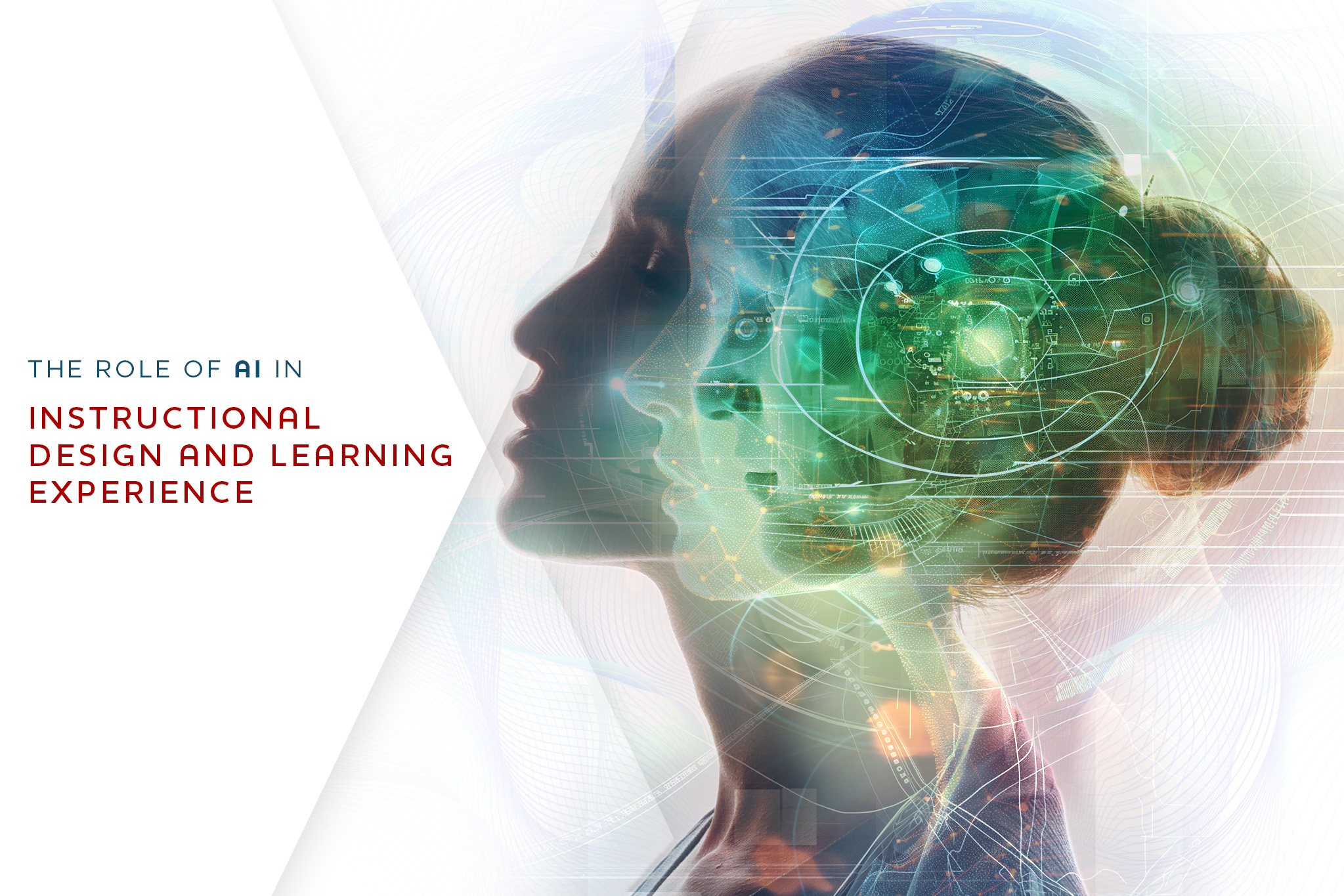AI plays a critical role in instructional design and learning experience design by enabling the integration of learning theories and design practices with powerful content generation technologies and leveraging the support of dynamic machine-generated analytics.
The integration of Artificial intelligence in design enhances the designers’ experience by increasing their efficiency and allowing them to focus more on creating a personalized learner experience.
AI-powered tools have transformed the way instructional designers create curriculum by automating many tasks and providing valuable insights. These tools can analyze source material and recommend relevant content to fill knowledge gaps. They also offer adaptive content delivery, allowing instructional designers to focus more on building engaging learning experiences rather than spending time on manual content curation.
Furthermore, AI can analyze large amounts of data, including learner interactions and performance, to identify patterns and trends and provide instructional designers with insights into learner interaction with the content they have created. This in turn prompts them to improve experiences with sustained learner engagement.
Understanding Artificial Intelligence in Education
Artificial Intelligence in education refers to the use of AI technologies, such as machine learning and natural language processing, to enhance teaching and learning experiences (Wang et al., 2021). AI technology can be utilized to create dynamic feedback systems, virtual reality simulations, and personalized learning platforms.
These AI-powered tools have the potential to revolutionize instructional design by providing real-time feedback, adaptive content delivery, and individualized learning paths for learners.
AI-driven personalization in education refers to the use of AI technologies to tailor educational experiences to the specific needs, preferences, and learning styles of individual learners.
The Impact of AI on Curriculum Development
The integration of AI into instructional design has the potential to impact curriculum development significantly. Educational designers should not discount the impact of Artificial Intelligence design outcomes on their professional growth roadmap.
AI-Powered Content Curation
Traditionally, one aspect of the instructional design method of building courses includes extensive time spent on source curation, research, analysis, outline identification, and content organization.
In this day and age, AI tools can analyze source material and recommend relevant content to include in the curriculum. By leveraging machine learning algorithms, these tools can identify and extract key information from various sources, saving instructional designers valuable time and effort. This allows designers to focus on integrating the recommended content into engaging learning experiences. Some examples of instructional design tools that leverage AI include LEAi and EasyGenerator.
Tools such as LEAi allow content developers to upload source materials available in different formats and produce outlines, objectives, and content that the designers can quickly review, modify, and enhance.
EasyGenerator, on the other hand, has inbuilt AI chat assistance that can be used at various relevant points within the content to prompt the creation of Knowledge Checks, assessment questions, Objectives, and so on.
Adaptive Learning Platforms
Learning Management Systems (LMS) and Learning Experience Platforms (LXP) are both types of educational software, but they serve different purposes. An LMS is a traditional platform designed primarily to deliver and track online training. It is often used by educational institutions and businesses to provide a structured learning environment, manage course enrollment, and evaluate learner performance through assessments and quizzes.
On the other hand, an LXP is a more modern solution that focuses on the learner’s experience, providing a personalized learning journey. LXPs use artificial intelligence to recommend educational content and encourage self-directed learning. They often integrate with a variety of content sources and are designed to enhance user engagement, offering a more social and collaborative approach to learning compared to the more administrative and compliance-focused LMS.
AI-powered adaptive learning platforms such as can adjust the curriculum based on individual learner progress and performance. These platforms use data analysis and machine learning to personalize the learning path for each student, providing a tailored educational experience. Instructional designers can leverage these platforms to offer more personalized and effective learning experiences to students, ensuring that the curriculum meets diverse learning needs.
AI-Powered Learning Analytics
AI-powered learning analytics involves the use of AI to analyze and interpret data collected from learners. These analytics can provide valuable insights into learner behavior, performance, and engagement, allowing instructional designers to make data-driven decisions in designing and modifying learning experiences.
These analytics tools can track student progress, identify areas of improvement, and provide actionable data to inform instructional design decisions.
AI can analyze data to identify gaps in knowledge, recommend relevant content or activities to fill those gaps and adapt the curriculum based on individual learner progress and performance.
The Evolution of AI in Learning Analytics
The integration of AI into learning analytics marks a pivotal shift in how data is utilized within LMS platforms. Initially, LMSs served primarily as repositories and platforms for course delivery, facilitating basic tracking of student progress and completion rates. However, the evolution of AI has led to an enhanced analytical framework, where vast amounts of educational data are not just collected but also intelligently analyzed. This progression can be delineated as follows:
Descriptive Analytics:
TEarly LMS systems offered descriptive analytics, providing rudimentary insights into what has happened within a course or program based on historical data. This included simple metrics such as participation rates, quiz scores, and completion times.
Diagnostic Analytics:
As analytics evolved, LMS began to incorporate diagnostic tools that could help educators understand why certain learning outcomes were happening. This involved more sophisticated data analysis that could identify patterns and correlations in student behavior.
Predictive Analytics:
The true leap forward came with the implementation of predictive analytics powered by AI. This advanced form of analytics uses machine learning algorithms to predict future student performance and learning outcomes based on past behaviors. It allows educators to proactively intervene and tailor the learning path for individual students.
Prescriptive Analytics:
The latest frontier in AI-powered learning analytics is prescriptive analytics, which not only predicts outcomes but also suggests the best courses of action to achieve desired educational goals. It leverages AI to create personalized learning experiences, recommend resources, and adjust content delivery in real-time to suit the unique needs of each learner.
This transformative journey of AI in learning analytics has fundamentally altered the role of LMS. No longer are they just platforms for content; they are now intelligent systems that can deeply understand the learning process and actively contribute to the success of each student. This has profound implications for the future of education, as AI-powered LMSs become not just tools for learning but partners in the educational journey, fostering a more engaging, effective, and personalized learning experience for students around the globe.
The Benefits of AI in Instructional Design
The benefits of AI in Instructional Design are building progressively. Some of these are covered in this section.
Personalized learning experiences:
AI can create customized learning paths and content based on individual learner needs and preferences, enhancing engagement and motivation.
Enhanced efficiency:
AI can automate repetitive tasks and provide instant feedback, saving time for both teachers and learners.
Improved learning outcomes:
AI can analyze data and provide targeted interventions to support learners in areas of weakness, leading to improved mastery of skills and knowledge.
Adaptive and responsive learning:
AI can adapt the content and pace of instruction based on individual learner progress and performance, ensuring that learners are challenged at the appropriate level and not overwhelmed or bored.
Increased accessibility:
AI technologies can provide personalized accommodations and support for learners with diverse needs, ensuring that no student is left behind.
Enhanced instructional design:
AI can analyze instructional strategies and learner data to optimize the design of learning materials, activities, and assessments, improving their effectiveness and promoting deeper learning.
The integration of AI in instructional design has the potential to revolutionize education by providing personalized learning experiences, improving efficiency, enhancing learning outcomes, promoting engagement and motivation, increasing accessibility, and optimizing instructional design (Hutson et al., 2022).
Actionable Insights for Instructional Designers on Leveraging AI Tools
These actionable insights can help you answer “How to become an instructional designer of Next Gen” by leveraging AI tools such as LEAi and EasyGenerator:
Conclusion:
The advent of Artificial Intelligence in the realm of instructional design heralds a transformative era in education. AI stands poised to:
Craft Tailored Learning Journeys:
By offering individually tailored learning experiences, AI ensures that each student’s unique needs and learning pace are accounted for.
Boost Efficiency and Outcomes:
It streamlines the educational process and enhances the effectiveness of learning, marking improvements in both efficiency and outcomes.
Elevate Engagement:
AI can significantly increase student engagement and motivation through interactive and dynamic content.
Enhance Accessibility:
With AI, learning opportunities become more accessible to a wider audience, overcoming traditional barriers.
Refine Design Strategies:
nstructional designers gain a powerful tool to fine-tune their methodologies, ensuring that training experiences are not only effective but also highly engaging.
Instructional designers are thus encouraged to embrace AI, using it as a strategic resource to enrich training programs. As designers transition into orchestrators of learning experiences, they can leverage AI to create adaptive educational environments bespoke to each learner. AI’s capability to analyze educational data and provide insightful feedback is invaluable, empowering designers to make informed decisions that elevate the learning experience.
In summary, AI’s integration into instructional design is not just promising; it’s a game-changer, offering boundless opportunities to redefine how we teach and learn.



![Experiential Learning for Patients and HCPs Beyond the Pamphlet [2025 Guide]](https://tipmedia.com/wp-content/uploads/2025/04/blogs_october_10-14_1 2.jpg)